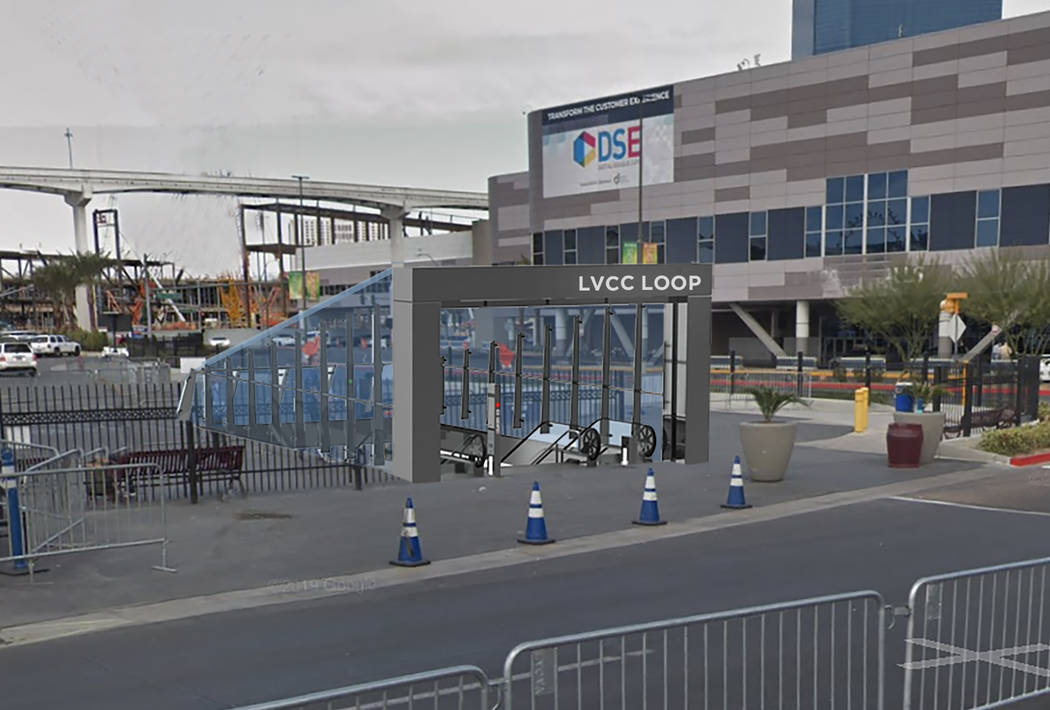People-mover to cut parking spaces at Las Vegas Convention Center
The underground people-mover project slated for the Las Vegas Convention Center will result in the loss of at least 450 parking spaces on the site.
Spaces would be eliminated to construct six aboveground entrances to the two underground stations planned for the nearly $50 million Elon Musk-owned Boring Co. project, according to plans submitted by the Las Vegas Convention and Visitors Authority to Clark County.
Conservative estimates project that up to 150 parking spaces will be removed from each of the three main parking lots to allow for the stations and aboveground entrances. After the spaces are removed, 5,342 spaces will remain in the convention center campus.
Parking fees average $10 per car during conventions and events at the facility.
Plans call for boring the tunnels underneath county right of way, which raises other issues.
“When you’re tunneling, there’s other stuff underground,” said Boring Co. President Steve Davis. “We’ve already started coordinating with dozens and dozens of stakeholders that have subsurface infrastructure. You have electric lines, gas lines, storm drains, etc. There’s a lot of stakeholders, and as part of this process we’re going to coordinate with all of them.”
One of those stakeholders is aboveground — the Las Vegas Monorail, which said it has already been coordinating with those involved with the tunnel project.
“There are portions of their station that is in the vicinity of some of our existing columns, so we were concerned about how testing or the construction of that might impact us,” said Jennifer Lazovich, a lobbyist for the Las Vegas Monorail Co. “We now have a much better feel for how they’re going to do it. We appreciate them working with us.”
4,400 passengers per hour
The project entails autonomous vehicles — made up of three Tesla models — making stops at three stations, two underground and one aboveground.
The exact location of the aboveground station is yet to be determined as plans for the project have to to be finalized, LVCVA spokeswoman Jackie Dennis said.
The capacity for the convention center project will be up to 4,400 passengers per hour, using between 90 and 140 vehicles, servicing five stations.
It would take just under two minutes to travel between the two farthest stations.
After the LVCVA initiated talks with the Boring Co. over a year ago about how the system could be used on the Strip, attention turned to the convention center as the expansion project planning was underway, which LVCVA CEO and President Steve Hill called “perfect timing.”
Going underground was attractive to the tourism authority, Hill said, instead of going with an elevated roadway with a tram similar to ones found at McCarran International Airport, as originally planned.
Part of the attraction is the lack of disruption associated with the process, including environmental and logistical issues usually present in other transportation projects.
“There’s no effect of weather during construction,” Davis said. “You’re not cutting up the road. You’re not reducing lanes. You have one place where you start digging, and nobody knows it’s happening the entire time.”
The underground route features two tunnels, one for each direction of travel, extending underneath a 0.83-mile portion of the convention center property and public right-of-way in a southeast to northwest orientation.
“A simple roadway, an electric vehicle and a glossy white tunnel,” Davis said. “Elon is a big fan of the glossy white.”
Minimal safety risks
County Commission Chairwoman Marilyn Kirkpatrick was concerned with how guests would be able to exit the tunnels in case one of the autonomous vehicles becomes inoperable.
Davis explained the process was simple and had minimal risks involved compared with other underground travel options, like subways, that often are difficult to evacuate in an emergency due to safety risks tied to the third rail or tight walking spaces.
“On loop there are no touch hazards,” he said. “Everything is battery powered … there’s nothing you can touch that will hurt you. If there is a vehicle that is stuck … you get out (of the vehicle) and walk out and you have the entire tunnel to walk through.”
Additionally, Davis said not to envision the tunnel as a giant line of cars going through at a time in close proximity to each other, as the vehicles in the tunnel will be separated by 500-600 feet on average, Davis said.
“You’ll probably never see the vehicle in front of you,” he said.
Plans also call for a pedestrian tunnel traveling under Swenson Street, allowing for safe crossing between a parking lot and the south hall. The LVCVA will foot the bill for the entire Boring Co. project, but it will not charge riders a fee to utilize the system.
Construction is slated to begin by September and be complete, safety tested and ready to be fully operational by January 2021.
“We want to make sure it’s done right, but we would also like to have it done quickly,” Hill said. “We’d like to have it available for our attendees when we open the new facility in January 2021.”
Contact Mick Akers at makers@reviewjournal.com or 702-387-2920. Follow @mickakers on Twitter.
Proposed convention center Boring Co. station locations
Station 1: Platinum Parking Lot, near the southeast corner of Swenson Street and Desert Inn Road. Southeast portion of the convention center.
Station 2: Northeast corner of the existing Silver Parking Lot, near the southeast corner of Paradise Road and Convention Center Drive. Central portion of the convention center.
Station 3: Southwest corner of the under-construction exhibit hall, near the northwest corner of Debbie Reynolds Drive and Convention Center Drive. Northwest portion of the convention center.
— In an alternative site plan, Station 1 could move to the Red Parking Lot to the west of Swenson, but the other two station locations would remain the same.


















